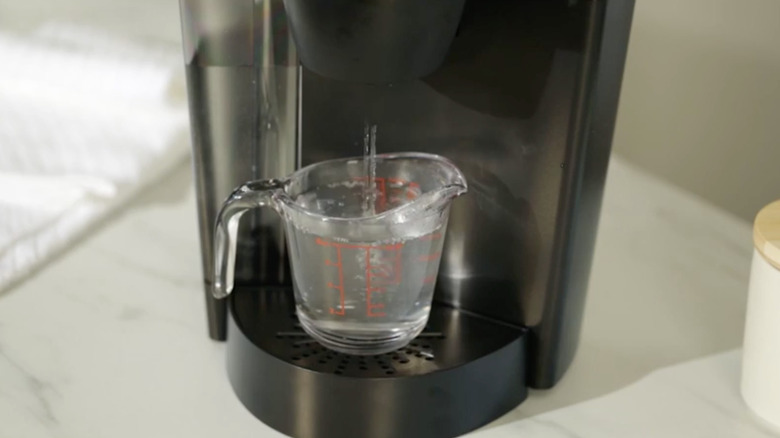The Downsides To Using Keurig Cleaning Pods
Keurig coffee makers are very easy to operate thanks to literal push-button functions but still require maintenance for their best performance. Regularly cleaning your Keurig helps ensure your coffee maker can brew cup after cup to get you through those bleary-eyed mornings. Now, when it comes to cleaning the machine, which option do you take? You can clean your Keurig the old-school way with soap and water, descaling it on your own, but is it easier to use a Keurig cleaning pod? Sometimes. Is it worth it? Not really. Relying on a cleaning pod to get your K-cup brewer squeaky clean has downsides — for one, it only cleans the pod holder.
Whether they're Keurig-brand rinse pods or a third-party option, a cleaning pod just can't measure up to a good cleaning. They don't clean the other components of your machine, such as the water reservoir and water line. In Keurig's own words, using the rinse pods is only to "reduce flavor carry-over between brews." It's not a mysterious brew of chemicals either, just maltodextrin, sodium bicarbonate, citric acid, and sodium citrate. Decoded, that's starch, baking soda, juice from a citrus fruit, and citric acid salt. So yes, a cleaning pod can help give you a better-tasting cup of coffee by rinsing away debris, but the actual use for the pod is limited, and you can replicate the cleaning pod with simple ingredients for the same effect. You may also discover there are other downsides to using the rinse pods.
You can expect to pay more for less
A rinse pod won't help you clean and descale your Keurig coffee maker either. Descaling is necessary to remove the mineral buildup from your water and ensure your Keurig runs smoothly. You will still need to descale your machine after using the rinse pod to ensure you clean your Keurig well. In particular, the Keurig's water reservoir needs regular maintenance, preferably weekly, to prevent mold growth. Sometimes your Keurig will clog, and you need to clean an overlooked spot: the needle. The rinse pods can't do any of these important tasks.
Another downside to using a Keurig rinse pod is the price: you'll pay around $8 for a box of 10. Keurig recommends you use a rinse pod every week, and if you follow this guidance, a box will last you less than two months. You will spend nearly $50 a year in rinse pods, yet still have to descale and clean the rest of the machine. If you're concerned about sustainability and use a reusable coffee filter in your Keurig, you will likely think the plastic waste from the rinse pods is also a point against their use. Overall, you'd be better cleaning with simple household ingredients, such as baking soda, water, and vinegar.

